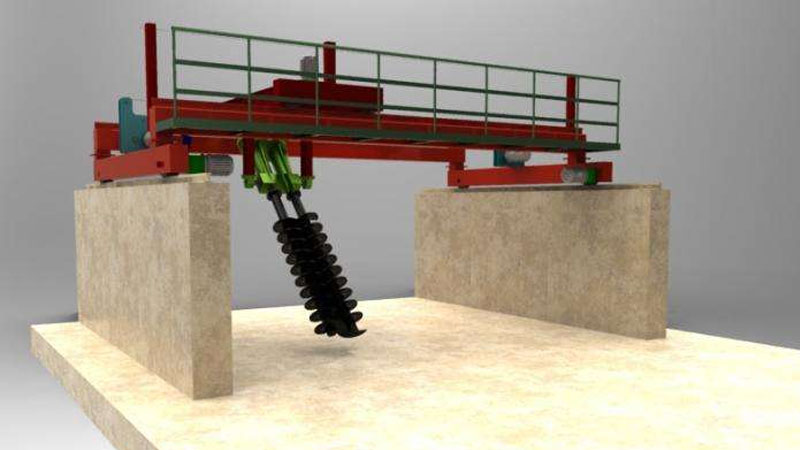Double helix dumpers can speed up the decomposition of organic waste. The composting equipment is simple to operate and highly efficient, and is not only widely used in the large-scale production of organic fertilizer, but also suitable for home-made organic fertilizer.

Installation and maintenance.
Check before the test.
l Check that the gearbox and lubrication point are adequately lubricated.
l Check the supply voltage. Rated voltage: 380v, voltage drop of not less than 15% (320v), not more than 5% (400v). Once beyond this range, the test machine is not allowed.
l Check that the connection between the motor and the electrical components is secure and ground the motor with wires to ensure safety.
l Check that the connections and bolts are secure. If loose must be tightened.
l Check the height of the compost.
No load test.
When the device is started, observe the direction of rotation, shut down as soon as it reverses, and then change the direction of rotation of the three-phase circuit connection. Listen to the gearbox for abnormal sounds, touch the bearing temperature, check if it is within the allowable temperature range, and observe whether the spiral stirring blades are rubbing against the ground.
With material test machine.
▽ start the dumper and the hydraulic pump. Place the double helix slowly at the bottom of the fermentation tank and adjust the double helix position according to the ground levelness: : .
The dumper blades are 30mm above the ground, and the ground comprehensive error is less than 15mm. If these blades are higher than 15mm, they can only be kept 50mm off the ground. During composting, the double helix is lifted automatically when the blades touch the ground to avoid damage to the compost machine equipment.
▽ should be shut down as soon as there is an abnormal sound throughout the test run.
▽ check that the electrical control system is working steadily.
Precautions for the operation of the double helix dumper.
▽ personnel should stay away from dumping equipment to prevent accidents. Remove the surrounding security hazards before the composter is turned on.
▽ do not fill the lubricant during production or repair.
▽ strictly in accordance with the prescribed procedures. Reverse work is strictly prohibited.
▽ non-professional operators are not allowed to operate the dumper. Operating the dumper is prohibited in the event of alcohol consumption, ill health or poor rest.
▽ for safety reasons, the dumper must be securely secured.
▽ power must be cut off when replacing slots or cables.
▽ When positioning the double helix, care must be taken to observe and prevent the hydraulic cylinder from being too low and damaging the blades.
Maintenance.
Check before powering on.
Check that the joints are secure and that the bearing clearance of the transmission components is appropriate. Inappropriate adjustments should be made in a timely manner.
Apply butter to the bearings and check the oil level of the transmission and hydraulic cylinders.
Make sure that the wire connection is secure.
Shutdown check.
Remove the machine and surrounding residues.
Lubricate all lubrication points.
Cut off the power supply.
Weekly maintenance.
Check the transmission oil and add full gear oil.
Check the contacts of the control cabinet contactors. If there is damage, replace it immediately.
Check the oil level of the hydraulic tank and the sealing of the oil path connector. If there is oil leakage should be replaced in a timely manner seal.
Regular maintenance.
Check the operation of the motor gearbox regularly. If there is abnormal noise or fever, stop immediately for inspection.
Check the bearings regularly for wear. Bearings with severe wear should be replaced in a timely manner.
Common troubleshooting and troubleshooting methods.
|
Fault. |
Reason. |
Troubleshooting method. |
|
It's hard to turn over piles. |
The pile of raw materials is too thick and too high. |
Remove the excess pile. |
|
It's hard to turn over piles. |
Bearing or blade outlier. |
Secure the blades and bearings. |
|
It's hard to turn over piles. |
The gear is damaged or stuck. |
Remove foreign objects or replace gears. |
|
The travel is not smooth, the gearbox has a noise or heat. |
Covered with foreign objects.
|
Remove foreign objects. |
|
The travel is not smooth, the gearbox has a noise or heat. |
Lack of lubricants. |
Fill the lubricant. |
|
It is difficult to power on, accompanied by a noise. |
Excessive wear or damage to bearings.
|
Replace the bearings. |
|
It is difficult to power on, accompanied by a noise. |
Bearing bias. or bent.
|
Correct or replace bearings. |
|
It is difficult to power on, accompanied by a noise. |
The voltage is too high or too low. |
Restart the dumper after the voltage is ok. |
|
It is difficult to power on, accompanied by a noise. |
The gearbox is lacking in lubricant or damaged. |
Check the gearbox and troubleshoot.
|
|
The dumper does not run automatically. |
Check the line for abnormalities.
|
Tighten the joints and check the control lines. |
Post time: Sep-22-2020

